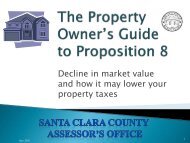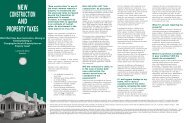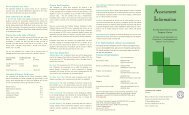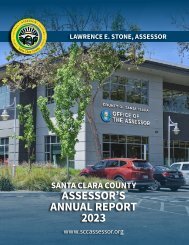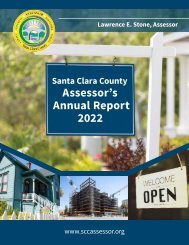Santa Clara County Assessor's Annual Report
Each year the Santa Clara County Assessor’s Office prepares an Annual Report available in hard copy and electronic versions. The report offers comprehensive statistical analysis of the local assessment roll, including all real and business property, legal exemptions, and assessment appeals. Assessment information is provided by property type, city, and school district. The Assessor’s Annual Report is an important source of information for public finance officials, real estate professionals, tax experts, academics, as well as business, government, and community leaders seeking insights into real estate trends in Santa Clara County.
Each year the Santa Clara County Assessor’s Office prepares an Annual Report available in hard copy and electronic versions. The report offers comprehensive statistical analysis of the local assessment roll, including all real and business property, legal exemptions, and assessment appeals. Assessment information is provided by property type, city, and school district.
The Assessor’s Annual Report is an important source of information for public finance officials, real estate professionals, tax experts, academics, as well as business, government, and community leaders seeking insights into real estate trends in Santa Clara County.
You also want an ePaper? Increase the reach of your titles
YUMPU automatically turns print PDFs into web optimized ePapers that Google loves.
Historical Trends of
Properties as Percent of
Total Assessed Value of All
Secured Properties
Roll Year Residential % Industrial %
2004 65.51% 34.49%
2005 67.38% 32.62%
2006 67.86% 32.14%
2007 67.67% 32.33%
2008 66.83% 33.17%
2009 65.46% 34.54%
2010 65.89% 34.11%
2011 66.72% 33.28%
2012 66.50% 33.50%
2013 66.95% 33.05%
2014 66.76% 33.24%
2015 65.55% 34.45%
2016 64.64% 35.36%
2017 64.19% 35.81%
2018 63.86% 36.14%
2019 63.90% 36.10%
2020 63.16% 36.84%
2021 63.07% 36.93%
$1,800,000
$1,600,000
$1,400,000
$1,200,000
$1,000,000
$800,000
$600,000
$400,000
$200,000
$-
Assessed Values in
Santa Clara County
This chart compares the total net assessed value of residential
properties to other property, including commercial and industrial
properties. Since Prop. 13 passed in 1978, the portion of the net
secured assessment roll of commercial and industrial properties
has declined 8 percent, a trend consistent with data from other
counties. The reason for this shift is likely the growth of residential
properties. Between 1978 and 2020, the number of residential
parcels grew by 49 percent, while the number of nonresidential
actually shrunk by 8 percent.Within a similar timeline,
the population grew 49 percent.
Properties as a Percent of Total Net
Assessed Value Of All Secured
Properties
80%
70%
56%
52% 56% 60% 67% 67%
60%
63%
50%
40%
48%
44%
44%
30%
40%
20%
33% 33%
37%
10%
0%
1970 1980 1990 2000 2010 2020 2030
Residential(SFR and Condo)
Non-Residential
Single Family Homes Average "Sale" Value Vs Average Assessed Value
1975 1980 1985 1990 1995 2000 2005 2010 2015 2020 2025
Average Sales Price
Average Assessed Value
Property Tax Exemptions
“Under Section 4(b) of Article XIII of the
California Constitution, the Legislature has the
authority to exempt property (1) used exclusively
for religious, hospital, or charitable purposes,
and (2) owned or held in trust by nonprofit
organizations operating for those purposes. This
exemption from property taxation, popularly
known as the welfare exemption, was first adopted
by voters as a constitutional amendment
on November 7, 1944. With this amendment,
California became the last of 48 states in the
country to provide such an exemption from
property taxes.
When the Legislature enacted Section 214 of
the Revenue and Taxation Code to implement
the Constitutional provision in 1945, a fourth
purpose, scientific, was added to the three
mentioned in the Constitution. Section 214
parallels and expands upon the Constitutional
provision that property used exclusively for the
stated purposes (religious, hospital, scientific,
or charitable), owned by qualifying nonprofit
organizations, is exempt from taxation if certain
requirements are met. An organization’s primary
purpose must be either religious, hospital, scientific,
or charitable. Whether its operations are for one of these purposes is determined by its activities. A qualifying
organization’s property may be exempted fully or partially from property taxes, depending on how much of the
property is used for qualifying purposes and activities.”*
The table entitled “Qualifying Exemption 2021-2022” illustrates the various types of properties receiving exemptions
in Santa Clara County, as well as the sum of those exemptions. As you can see, the magnitude of the welfare
and institutional exemptions dwarfs the more commonly known homeowners’ exemption.
Santa Clara County’s Largest Exemption: Stanford University
“The College Exemption is available to property used exclusively for educational
purposes by a nonprofit educational institution of collegiate grade. The property
may be either owned or leased, but it must be used for educational purposes as
of the January 1 Lien Date. Buildings under construction or renovation, and the
land required for their convenient use, and equipment in them may also qualify
for the exemption if the intended use when completed will qualify the property for
exemption … The courts have construed that ‘used exclusively for the purposes
of education’ to include any facilities that are ‘reasonably necessary for the fulfillment
of a generally recognized function of a complete and modern college.’” **
Leland Stanford Junior University, founded in 1885, is granted the title of the largest
exemption in Santa Clara County annually. With 357 total exempt properties,
the exemptions at the time of the 2021 Lien Date summed up to $15,954,808,967.
This figure includes Stanford Medical Center and the Lucille Packard Children’s
hospital, teaching and research institutes.
*Assessors’ Handbook, Section 267, Welfare, Church, and Religious Exemptions
**The College Exemption is provided for in Section 3(e) of Article XIII of the California Constitution, implemented
by Section 203 of the Revenue and Taxation Code
Qualifying Exemptions 2021-2022
Private and Parochial Schools
(less than Collegiate Grade)
Exemption Roll Unit Total Value
138 $847,721,585
Hospitals 39 $2,160,030,936
Other Religious and Charitable Properties 1,537 $8,855,317,188
Religious Properties 616 $904,969,220
Disabled Veterans 1,057 $144,712,386
Churches 95 $150,652,184
Privately Owned Colleges 492 $17,462,788,977
Cemetery 35 $181,801,237
Historical Aircraft 7 $322,586
Other 76 $625,051,309
Total Non-Reimburseable Exemptions 4,092 $31,333,367,608
Reimburseable Exemptions
(Homeowners’ Exemptions)
245,579 $1,721,855,800
Total Exemptions 249,671 $33,055,223,408
14
Santa Clara County Assessor’s Annual Report 2021-22 Santa Clara County Assessor’s Annual Report 2021-22
15



